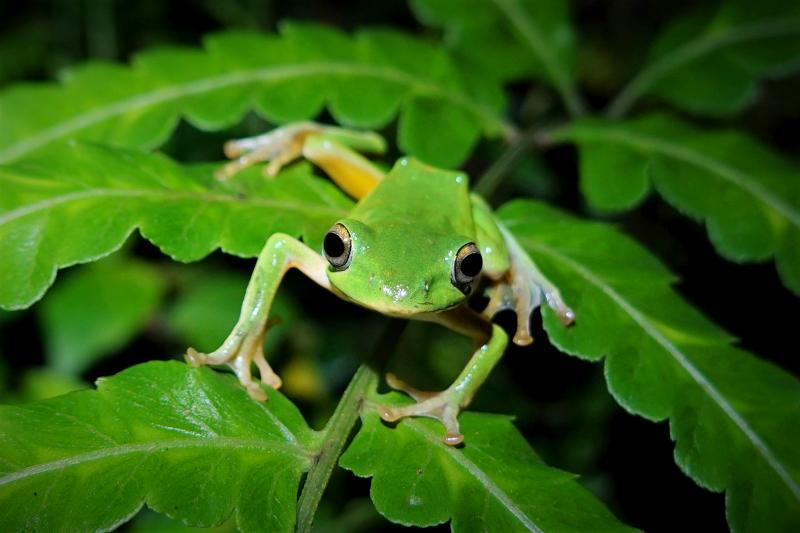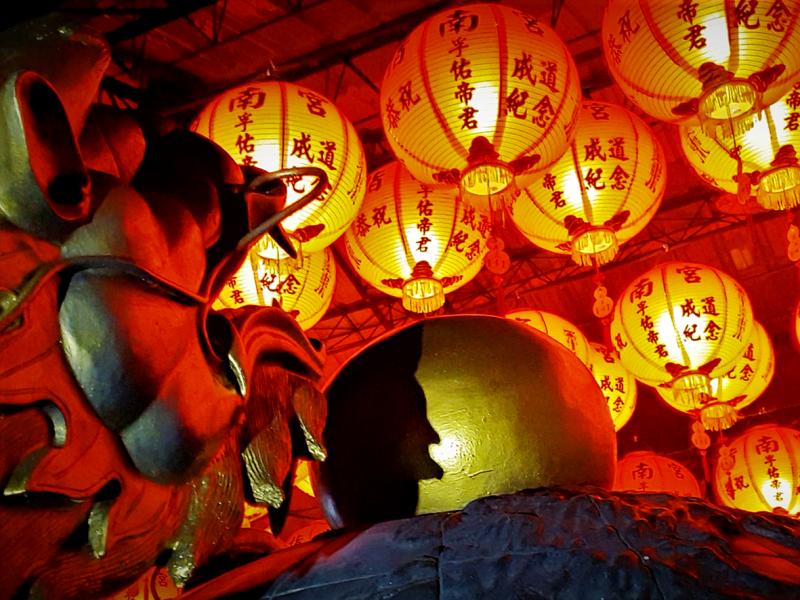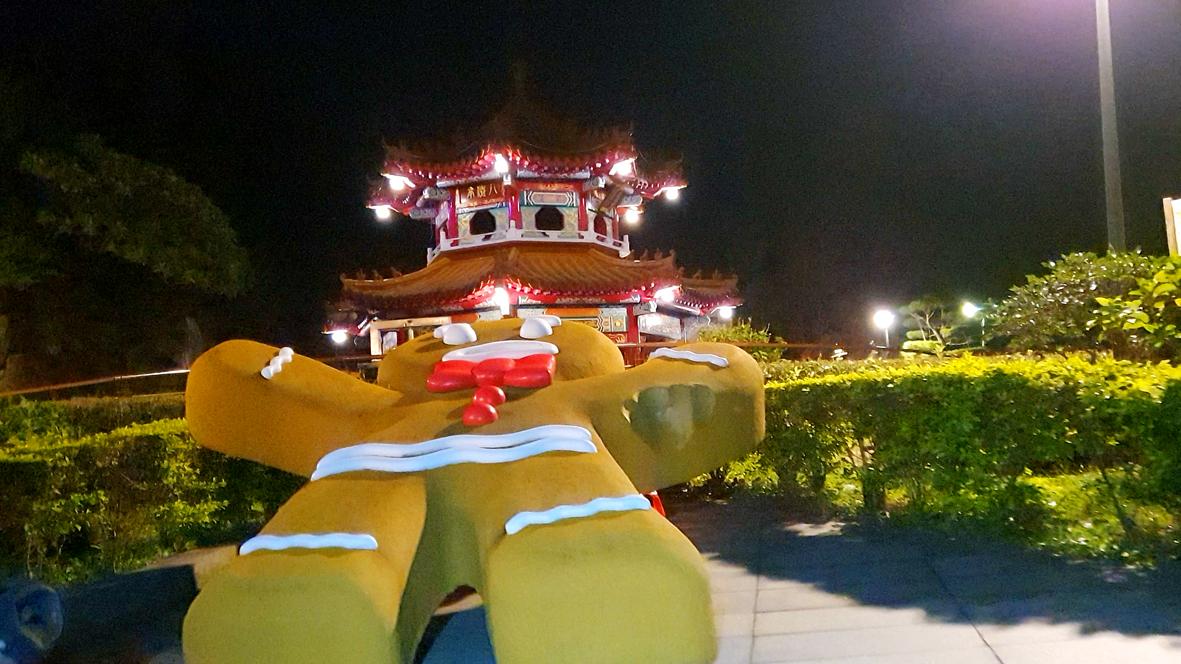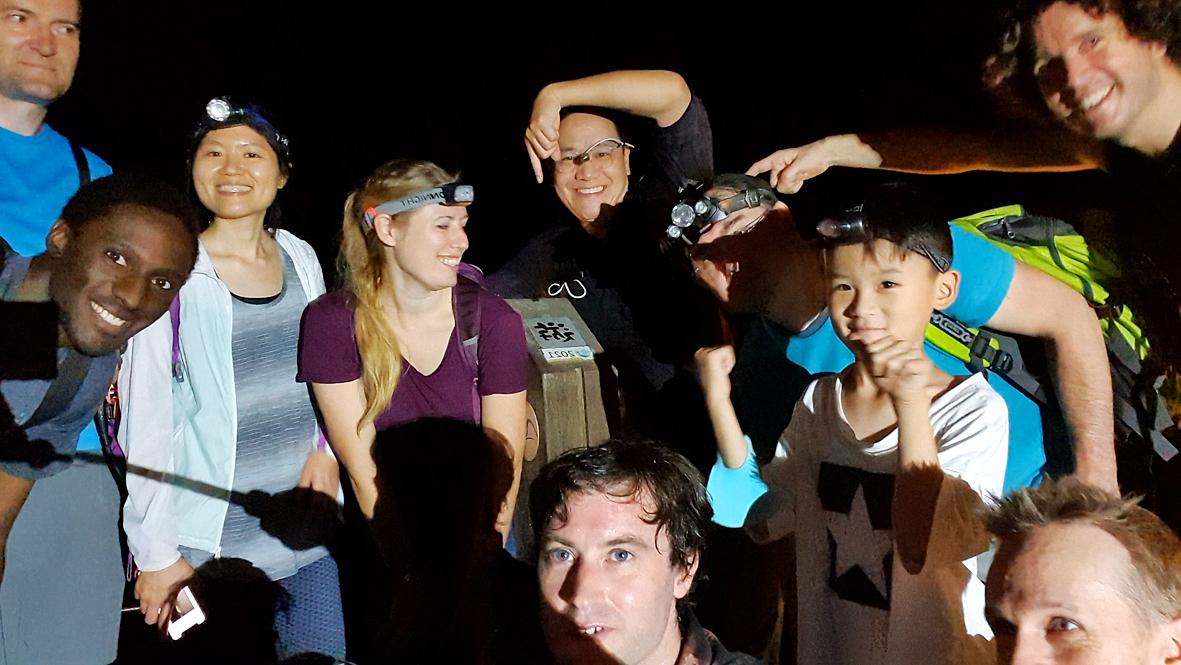We weave our way through an old cemetery in the dark, as the sound of our quarry gets closer. At the foot of an old tomb, beneath a pile of rubble, we find what we are looking for.
Tonight we embark on the seventh and final stage of the Taipei Grand Trail (台北大縱走). Starting with an ascent up to Zhinan Temple (指南宮), on past the famous Maokong Potholes (貓空壺穴), we then meander through the tea plantations and tea houses overlooking Taipei city, finally ending the epic adventure back down at National Chengchi University (國立政治大學).
This section was deliberately left until the end of autumn as we hoped to include some Taipei tree frogs, their breeding season being the colder winter months. We are not sure whether or not we are too early in the season, or even whether or not there would be a breeding area along these trails.

Photo: James Osborne
The first hour or so, we climb a well-maintained stone walkway out of the city and on up toward Zhinan Temple and its surrounding temples. We encounter a few frogs and many cats, which is fitting as this is Maokong, which literally translates as “cat space.” The temples themselves are a rewarding sight, with glowing red lanterns hanging above golden dragons and ornately carved stone motifs.
Fourteen people, most of which are new faces, make up the final leg of our journey. We wind our way between the temples, forest paths and a short stretch of road. So far there are few animals out and no sound of the Taipei tree frogs’ mating call. But we have only begun and know there will be something on the trail ahead.
SNAKES ON THE POTHOLES

Photo: James Osborne
As we are about to re-enter the forest, we see that the trail has been closed off for maintenance. We are a bit baffled as to why the trail would be closed for six months during the very year it is being promoted by the government. We soon notice there is still a way through, although we are unsure if we are officially allowed to enter. Heeding a “caution wet paint” sign, we proceed nonetheless.
Navigating piles of brick and stone, we make our way along the trail and arrive at a small waterfall. As we approach the base of the waterfall for a better look, I slip on the mossy rocks and land hard on my butt. I managed to keep my cameras safe and nothing is broken, so we carry on.
“It’s right there,” Micah points up into the dark forest.

Photo: James Osborne
His father asks him to be more specific — but there it is, our first snake of the night: a venomous green tree viper.
We soon see a green frog sitting up in some branches. It’s an emerald tree frog. Not the Taipei tree frog, but it is another real gem of a frog, and the only one we have encountered on the Grand Trail so far. The sighting certainly is a treat, and we take some time to get a few photos before moving on.
We reach the potholes, which is a stretch of bedrock full of small holes and hollows carved out by the stream.

Photo: James Osborne
“Woah,” someone exclaims, recoiling their hand from a branch they were about to grab as another green tree viper waits in ambush.
FOUND IT!
After a few photos, we notice another viper in a trail-side tree a mere few meters further on. Now the night is kicking off and wildlife is revealing itself.
Before long, we are back on the road that meanders through the tea plantations and tea houses of Maokong. At this point, three of our party leave early on a taxi as it’s getting late on a Sunday night. Somewhere out in the plantations, we hear the end of season calls of more emerald tree frogs. Light rain sets in, but yet no sound of the tree frogs we are looking for. We pass many cat themed shops and motifs. Another roadside green tree viper entertains us for a moment.
“Wait. Listen.” Beyond a field of tea, off in the edge of the darkness in a scattering of tombs on the side of the hill, I finally hear the sound I had been listening for the whole night: the call of Taipei tree frogs.
“But it’s a cemetery,” someone points out. We proceed anyway.
Triangulating in on the sound of the frogs, we approach a rather run-down tomb with a pile of rubble and an old tarpaulin at its foot. Knowing that the males sit and call from depressions in the ground, I am sure that this is the only place it could be. Lifting the edge of the tarp, there it is, a Taipei green tree frog.
We soon spot another resting up among some vines — a female trying to decide which male’s call is more appealing. We appreciate the very satisfying moment to have found both a male and female before continuing on.
MISSION ACCOMPLISHED
Another trail brings us back down toward the end of the road, and we spot a few more critters on the way. We enjoy some final views of Taipei from Zhangshan Temple (樟山寺) before the final descent.
“A Formosan wolf snake,” shouts Candy, “or maybe a krait. Hurry.” Having just filmed everyone walk by, I rush back just in time to see the tail of a highly venomous many-banded krait disappear into the undergrowth. The non-poisonous wolf snake is the only common species we did not see on the entire Grand Trail.
Of course, there is one more green tree viper to wish us farewell as we complete the last stretch of trail. Just to keep things exciting until the very end, the trail is completely walled off behind an iron fence.
After a not-so-safe rope descent down a stone wall, we look back at the signs on the fence saying that the trail is strictly off limits. Had we just spent the last few months illegally doing the Grand Trail? No, someone had just neglected to remove the barrier since level 3 COVID-19 restrictions were lifted four months prior.
It was an exhilarating moment to stand there together at the end of the trail. The sheer abundance of biodiversity far exceeded my expectations, but the people who came along made the journey even more memorable. Some had done multiple stages, and others just for one or two.
With the 92km Taipei Grand Trail completed, what new expedition should we embark on when the spring brings all the wildlife back out?
James Osborne has spent the latter half of last year hiking and filming the Taipei Grand Trail at night, and sharing all his nocturnal wildlife discoveries. Two of his videos have won first place in government-sponsored competitions. Check out his YouTube channel (James Osborne) for these videos and other ecological adventures.

The canonical shot of an East Asian city is a night skyline studded with towering apartment and office buildings, bright with neon and plastic signage, a landscape of energy and modernity. Another classic image is the same city seen from above, in which identical apartment towers march across the city, spilling out over nearby geography, like stylized soldiers colonizing new territory in a board game. Densely populated dynamic conurbations of money, technological innovation and convenience, it is hard to see the cities of East Asia as what they truly are: necropolises. Why is this? The East Asian development model, with

June 16 to June 22 The following flyer appeared on the streets of Hsinchu on June 12, 1895: “Taipei has already fallen to the Japanese barbarians, who have brought great misery to our land and people. We heard that the Japanese occupiers will tax our gardens, our houses, our bodies, and even our chickens, dogs, cows and pigs. They wear their hair wild, carve their teeth, tattoo their foreheads, wear strange clothes and speak a strange language. How can we be ruled by such people?” Posted by civilian militia leader Wu Tang-hsing (吳湯興), it was a call to arms to retake

This is a deeply unsettling period in Taiwan. Uncertainties are everywhere while everyone waits for a small army of other shoes to drop on nearly every front. During challenging times, interesting political changes can happen, yet all three major political parties are beset with scandals, strife and self-inflicted wounds. As the ruling party, the Democratic Progressive Party (DPP) is held accountable for not only the challenges to the party, but also the nation. Taiwan is geopolitically and economically under threat. Domestically, the administration is under siege by the opposition-controlled legislature and growing discontent with what opponents characterize as arrogant, autocratic

Desperate dads meet in car parks to exchange packets; exhausted parents slip it into their kids’ drinks; families wait months for prescriptions buy it “off label.” But is it worth the risk? “The first time I gave him a gummy, I thought, ‘Oh my God, have I killed him?’ He just passed out in front of the TV. That never happens.” Jen remembers giving her son, David, six, melatonin to help him sleep. She got them from a friend, a pediatrician who gave them to her own child. “It was sort of hilarious. She had half a tub of gummies,